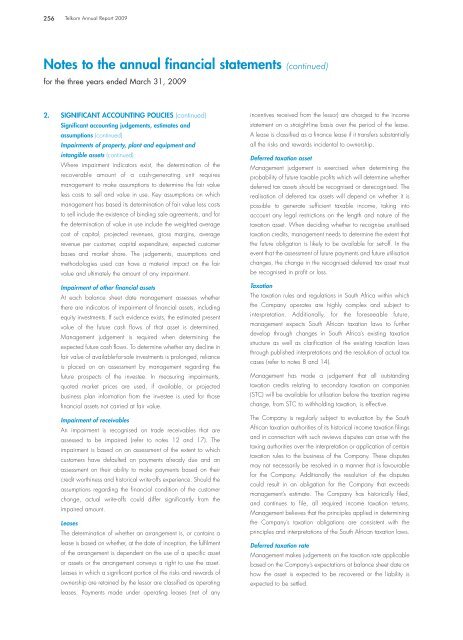Telkom AR front.qxp
Telkom AR front.qxp
Telkom AR front.qxp
You also want an ePaper? Increase the reach of your titles
YUMPU automatically turns print PDFs into web optimized ePapers that Google loves.
256<br />
<strong>Telkom</strong> Annual Report 2009<br />
Notes to the annual financial statements (continued)<br />
for the three years ended March 31, 2009<br />
2. SIGNIFICANT ACCOUNTING POLICIES (continued)<br />
Significant accounting judgements, estimates and<br />
assumptions (continued)<br />
Impairments of property, plant and equipment and<br />
intangible assets (continued)<br />
Where impairment indicators exist, the determination of the<br />
recoverable amount of a cash-generating unit requires<br />
management to make assumptions to determine the fair value<br />
less costs to sell and value in use. Key assumptions on which<br />
management has based its determination of fair value less costs<br />
to sell include the existence of binding sale agreements, and for<br />
the determination of value in use include the weighted average<br />
cost of capital, projected revenues, gross margins, average<br />
revenue per customer, capital expenditure, expected customer<br />
bases and market share. The judgements, assumptions and<br />
methodologies used can have a material impact on the fair<br />
value and ultimately the amount of any impairment.<br />
Impairment of other financial assets<br />
At each balance sheet date management assesses whether<br />
there are indicators of impairment of financial assets, including<br />
equity investments. If such evidence exists, the estimated present<br />
value of the future cash flows of that asset is determined.<br />
Management judgement is required when determining the<br />
expected future cash flows. To determine whether any decline in<br />
fair value of available-for-sale investments is prolonged, reliance<br />
is placed on an assessment by management regarding the<br />
future prospects of the investee. In measuring impairments,<br />
quoted market prices are used, if available, or projected<br />
business plan information from the investee is used for those<br />
financial assets not carried at fair value.<br />
Impairment of receivables<br />
An impairment is recognised on trade receivables that are<br />
assessed to be impaired (refer to notes 12 and 17). The<br />
impairment is based on an assessment of the extent to which<br />
customers have defaulted on payments already due and an<br />
assessment on their ability to make payments based on their<br />
credit worthiness and historical write-offs experience. Should the<br />
assumptions regarding the financial condition of the customer<br />
change, actual write-offs could differ significantly from the<br />
impaired amount.<br />
Leases<br />
The determination of whether an arrangement is, or contains a<br />
lease is based on whether, at the date of inception, the fulfilment<br />
of the arrangement is dependent on the use of a specific asset<br />
or assets or the arrangement conveys a right to use the asset.<br />
Leases in which a significant portion of the risks and rewards of<br />
ownership are retained by the lessor are classified as operating<br />
leases. Payments made under operating leases (net of any<br />
incentives received from the lessor) are charged to the income<br />
statement on a straight-line basis over the period of the lease.<br />
A lease is classified as a finance lease if it transfers substantially<br />
all the risks and rewards incidental to ownership.<br />
Deferred taxation asset<br />
Management judgement is exercised when determining the<br />
probability of future taxable profits which will determine whether<br />
deferred tax assets should be recognised or derecognised. The<br />
realisation of deferred tax assets will depend on whether it is<br />
possible to generate sufficient taxable income, taking into<br />
account any legal restrictions on the length and nature of the<br />
taxation asset. When deciding whether to recognise unutilised<br />
taxation credits, management needs to determine the extent that<br />
the future obligation is likely to be available for set-off. In the<br />
event that the assessment of future payments and future utilisation<br />
changes, the change in the recognised deferred tax asset must<br />
be recognised in profit or loss.<br />
Taxation<br />
The taxation rules and regulations in South Africa within which<br />
the Company operates are highly complex and subject to<br />
interpretation. Additionally, for the foreseeable future,<br />
management expects South African taxation laws to further<br />
develop through changes in South Africa’s existing taxation<br />
structure as well as clarification of the existing taxation laws<br />
through published interpretations and the resolution of actual tax<br />
cases (refer to notes 8 and 14).<br />
Management has made a judgement that all outstanding<br />
taxation credits relating to secondary taxation on companies<br />
(STC) will be available for utilisation before the taxation regime<br />
change, from STC to withholding taxation, is effective.<br />
The Company is regularly subject to evaluation by the South<br />
African taxation authorities of its historical income taxation filings<br />
and in connection with such reviews disputes can arise with the<br />
taxing authorities over the interpretation or application of certain<br />
taxation rules to the business of the Company. These disputes<br />
may not necessarily be resolved in a manner that is favourable<br />
for the Company. Additionally the resolution of the disputes<br />
could result in an obligation for the Company that exceeds<br />
management’s estimate. The Company has historically filed,<br />
and continues to file, all required income taxation returns.<br />
Management believes that the principles applied in determining<br />
the Company’s taxation obligations are consistent with the<br />
principles and interpretations of the South African taxation laws.<br />
Deferred taxation rate<br />
Management makes judgements on the taxation rate applicable<br />
based on the Company’s expectations at balance sheet date on<br />
how the asset is expected to be recovered or the liability is<br />
expected to be settled.




